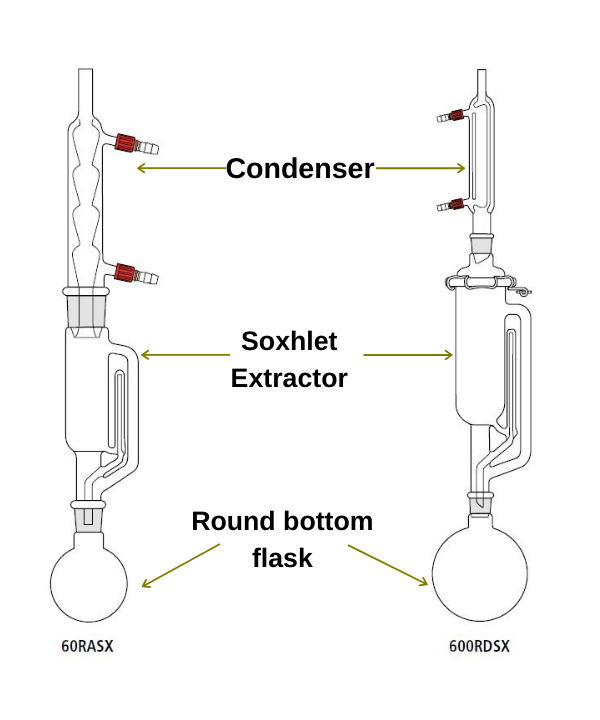Soxhlet extraction is used for extracting a compound of low solubility from a solid sample (typically natural or environmental samples such as soil, sediment and more). It was invented by Franz von Soxhlet in 1879 for the extraction of a lipid from a solid sample and has since become widely used the world over. The Soxhlet extraction method uses a number of different glassware pieces. A Soxhlet extractor is placed between a condenser and a flask. The refluxing solvent from the flask is heated and washes over the solid placed within the Soxhlet extractor. As a result, the desired low solubility compound is extracted out and siphoned into the flask.
Quickfit glassware can provide an easy solution to creating this set up as each piece of glassware has a specified joint size, which slots simply into other pieces with corresponding joint sizes. If joint sizes do not match, then there are a wealth of
adapters available. Also, to make things even simpler if required, Quickfit produce a number of
complete Soxhlet assemblies including matching flask, condenser and extractor in volumes ranging from 20ml up to 2000ml.

To complete Soxhlet extraction apparatus you will need the following
1. Round bottom flask - This is filled with your solvent of interest. Available in a huge selection of sizes -
5ml to 250ml and
500ml to 10L.
2. Soxhlet Extractor - The extractor itself will extract the impurities from your solid via a repeated soaking/siphoning with the solvent. Available as a
standard capacity and
large capacity piece.
3. Condenser - the condenser is used to condense your heated solvent which drips back into the Soxhlet extractor. Quickfit condensers have 13mm screwthread inlets and outlets, attaching tubing with approx. 9mm bore.
4. Extraction Thimbles (to fit the Soxhlet extractor) - it is a porous thimble made of either
cellulose,
glass microfibre or quartz microfibre. You place your solid sample within the thimble and then this is placed within the Soxhlet extractor.
[toggle title="How to select the right thimble?"] There are two main considerations when selecting an extraction thimble - size and material. The size of the thimble will need to fit tightly inside your extractor, so you need to consider the length and diameter. Finally there is material. Extraction thimbles are made of either cellulose, glass microfibre or quartz. For most general applications cellulose is suitable. However if your application is at temperatures higher than around 120°C (which is the limit of most cellulose thimbles) then you will need to consider using a glass microfibre thimble. For even higher temperature applications, you should choose quartz. The same is correct for applications involving acidic gases, in which case you will also want to use the more chemically resistant glass microfibre or even quartz thimbles. [/toggle]
5. Heating mantle - used to heat your flask containing the solvent. Mantles can be one place or multi-place to accommodate multiple extractions at once. Available
here.
6. Tubing - rubber tubing is used to connect your condenser up to a cold water source.
This tubing will connect to the Quickfit screw thread inlet and outlets.
7. Retort stand and clamps - to hold all of your glassware securely in the upright position. Available
here.
We have also written a post on how to set up Quickfit distillation apparatus, check that out
here.
If you have any questions or require guidance on setting up your glassware, you can contact us at
support@camlab.co.uk








